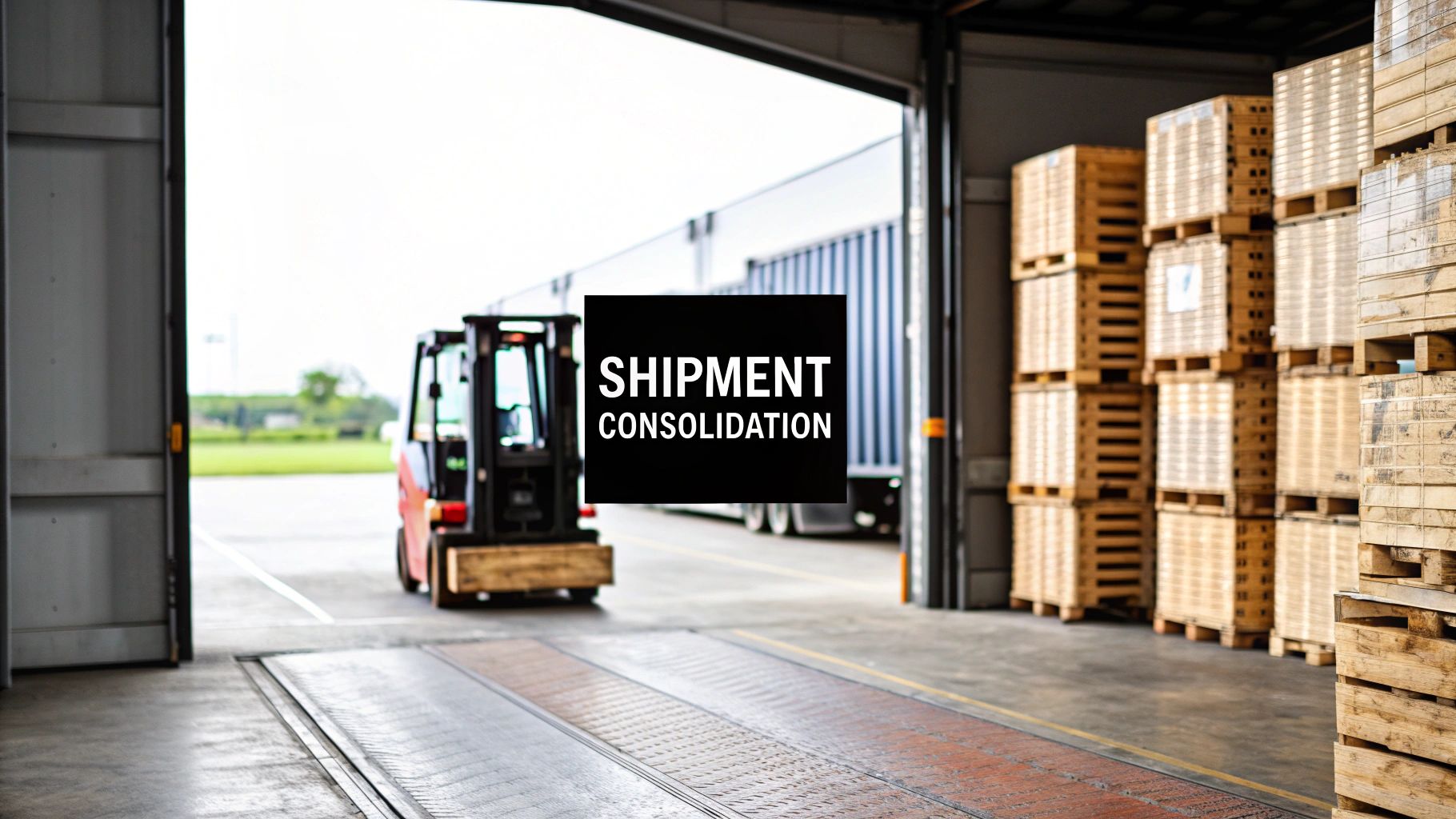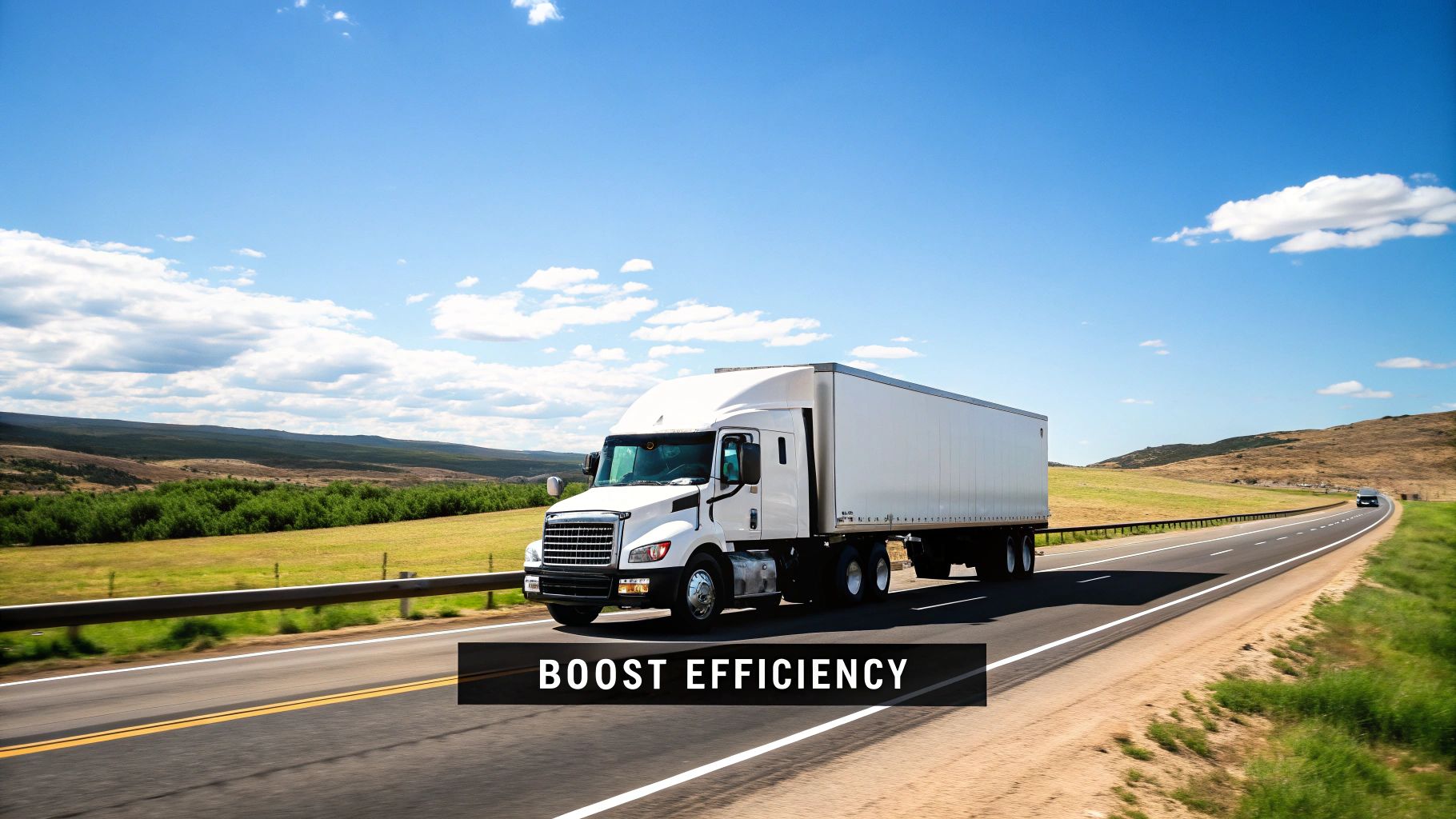Discover how the consolidation of shipments reduces freight costs and boosts efficiency. Optimize your supply chain with our expert strategies.

Here’s a simple way to think about it: imagine you and two friends are all sending small packages to the same city. Instead of each of you paying for a separate delivery service, you could just put everything into one big box and split the cost. That, in a nutshell, is the core idea behind shipment consolidation.
It’s a smart shipping strategy where you bundle multiple smaller Less-Than-Truckload (LTL) shipments into one single, efficient Full Truckload (FTL) shipment.

At its heart, shipment consolidation is a logistics practice that completely changes the game for moving goods. Instead of treating every small order like its own separate puzzle piece, you're putting all the pieces together to create one complete picture. This isn't just a tactic for massive corporations; it’s a game-changer for businesses of all sizes, from e-commerce startups to well-established manufacturers.
This approach tackles a very common, and often expensive, inefficiency in the shipping world. So many companies regularly send out LTL shipments that only use a fraction of a truck's available space. Each of those individual shipments comes with its own base costs, handling fees, and transit schedules.
By grouping these smaller loads that are heading in the same general direction, you create a single, larger shipment that is far more cost-effective and much simpler to manage. For a deeper dive, it's helpful to start by understanding the broader field of logistics management, which sets the stage for smart processes like consolidation.
The real impact of consolidation becomes crystal clear when you compare it to the old way of sending out a bunch of separate LTL shipments. With individual LTLs, your freight is constantly stopping at carrier terminals, getting handled over and over, which dramatically increases the risk of damage.
Consolidation, on the other hand, creates a much more direct journey for your goods. It’s a bit like taking a non-stop flight instead of one with three layovers. To learn more about different shipping methods, feel free to check out our guide on https://www.freightquotesnow.com/blog/less-than-container-load-shipping.
So, ask yourself: Is your business sending multiple LTL shipments to the same region? If the answer is yes, you could be saving money right now.
To help you see the benefits right away, we’ve put together a simple comparison table.
This table breaks down the key differences between sending out multiple individual LTL loads and combining them into a single, consolidated FTL shipment.
As you can see, the advantages of moving from scattered LTL shipments to a single consolidated truckload are pretty compelling, touching everything from your bottom line to your operational sanity.

When people think about shipment consolidation, the first thing that comes to mind is saving money. And they’re not wrong—it’s a huge perk. Instead of paying separate base rates, fuel surcharges, and other fees for a bunch of smaller LTL shipments, you combine them into one full truckload (FTL). You pay a single, much more favorable rate. That simple switch can make a serious dent in your freight spend.
But the real magic of consolidation goes way beyond just the bottom line. It touches almost every part of your supply chain.
A massive, and often overlooked, advantage is how much it cuts down on product damage. Picture a typical LTL shipment. It gets loaded and unloaded multiple times as it hops from terminal to terminal. Every single one of those stops is a new chance for a box to get dropped, crushed, or even lost in the shuffle.
With a consolidated FTL shipment, it's a completely different story. Your freight is loaded once at the start and isn't touched again until it reaches the destination hub. This "one-touch" journey means far less handling, which directly translates to fewer damages, a lot less time spent on claims, and customers who are much happier with what they receive.
Here’s something that might seem a bit backward at first: waiting to group shipments can actually make them get there faster. How? A full, consolidated truckload travels a direct route, completely bypassing the complex "hub-and-spoke" system that LTL carriers rely on. This means your freight isn't sitting around for days in various terminals waiting for the next leg of its journey. If you want to dive deeper into that network, you can learn more about what an LTL carrier is and see how their system works.
On top of everything else, a smart consolidation strategy is a big win for the environment. Fewer trucks hauling the same amount of goods means less fuel burned and a smaller carbon footprint. It’s that simple.
By making sure every truck is as full as possible, companies can slash their carbon footprint by up to 40%. This makes consolidation a powerful tool for building a greener, more responsible supply chain.
This isn't just about feeling good, either; it resonates with today's environmentally conscious customers and strengthens your brand. In a world of rising freight costs and tricky tariffs, consolidation of shipments has become a go-to strategy. In fact, recent data showed a massive 32.2% jump in units shipped year-over-year, even as the total number of orders dropped by 20%. It’s a clear sign that businesses are getting smarter by sending fewer, but much fuller, loads to keep costs in check.
When you add it all up—the cost savings, the reduced damage, the faster transit times, and the green benefits—you see that logistics stops being just an expense. It becomes a genuine competitive advantage.
Building a smart consolidation of shipments strategy might sound like a huge undertaking, but it really just boils down to a few practical steps. It all begins with taking a good, hard look at your own shipping patterns. The idea is to create a simple playbook that actually saves you money and makes your logistics run smoother.
Your first move? Dig into your shipping data. Go through your past shipments and hunt for patterns. Are you sending a bunch of separate LTL shipments to the same city or distribution hub week after week? This data is your goldmine—it points you right to your best consolidation opportunities.
You don't need a fancy system for this, either. A quick export of your shipping history into a spreadsheet can often show you clusters of destinations that are ripe for consolidation. Once you spot these regular routes, you can start being more deliberate with your shipping schedule.
Finding the opportunities is one thing, but making it happen requires some coordination. This really comes down to clear communication and flexible scheduling with both your suppliers and your customers. When you can get your inbound shipments from vendors to line up with outbound orders to customers, you create a much more efficient flow of goods.
For instance, you might decide to hold a few orders for an extra day so you can group them with others heading to the same region. That small delay upfront can actually lead to faster delivery overall because the consolidated truckload can skip several LTL terminals. Making this work requires a solid plan, and good inventory forecasting techniques are crucial for ensuring you have the right products ready to go at the right time.
This infographic breaks down the core steps for building a consolidation strategy from the ground up.

As you can see, a winning strategy starts with analyzing your data, moves into active coordination, and ends with implementation using the right partners and tools.
Here's the good news: you don’t have to orchestrate this complex dance all by yourself. The right technology and partners are key to making a consolidation program work without giving you a headache.
A 3PL brings the experience and the infrastructure needed to manage the staging, scheduling, and multi-stop truckloads that make consolidation possible. This lets you get all the benefits of consolidation without pulling your team away from what they do best. By following this approach, any business can turn its shipping department from a major cost into a real strategic advantage.

The idea behind shipment consolidation sounds good on paper, but where the rubber really meets the road is in the numbers. Let's move past the theory and dive into a couple of real-world scenarios where businesses turned logistical headaches into major wins for their bottom line.
Seeing how it works for others makes it much easier to picture what’s possible for your own business.
Picture a small but growing e-commerce brand shipping out of a warehouse in the Midwest. Every week, they find themselves sending 15 to 20 individual packages to customers clustered in the Los Angeles metro area. With each parcel costing about $18 to ship, they were spending around $360 a week just for that one destination.
Then they switched things up. Instead of shipping daily, they started holding those LA-bound orders and grouping them onto a single pallet. They sent that pallet via LTL to a local delivery partner in California, who then handled the final-mile deliveries.
Before Consolidation: 20 parcels x $18/parcel = $360
After Consolidation: 1 LTL pallet + last-mile fees = $250
That simple change saved them $110 every week, slashing their shipping costs for that route by a whopping 30%.
Now, let's look at a manufacturer in Ohio. They were regularly sending three separate LTL shipments to three different distributors across Texas. Each of those LTL shipments ran them about $750 and took a full five days to arrive because of all the stops at different terminals.
They made a smart move and consolidated all three shipments into one multi-stop full truckload. The truck now makes a single pickup at their factory and then drives directly to each of the three distributors. The difference was immediate.
Not only did they pocket an extra $500 (a 22% cost reduction), but their products also reached distributors two days sooner. That’s a huge win for improving partner relationships and getting paid faster.
This kind of strategic thinking became absolutely essential during the market chaos of the early 2020s. We saw carriers increasing blank sailings to deal with overcapacity, with a 13% jump in canceled voyages from China to the U.S. West Coast alone. If you're curious about how shippers navigated that period, you can read about container shipping strategies on wns.com. These examples prove that consolidation isn't just a cost-cutting trick—it's about building a smarter, more resilient supply chain.
https://www.youtube.com/embed/O5u-8fcyRHE
Trying to implement a successful shipment consolidation program doesn't mean you have to go it alone. In fact, bringing in a logistics expert is often the smartest and fastest way to get the most out of your efforts. A great partner takes all the heavy lifting off your team, turning what looks like a complex logistical puzzle into a simple, money-saving solution.
But how do you find the right one? A top-notch third-party logistics (3PL) provider does a lot more than just move boxes from A to B; they become a strategic part of your business. They bring deep industry knowledge, powerful technology, and a massive network to the table, always looking for new ways to cut your costs.
Ready to see how a partner can improve your FTL or LTL freight? Get an instant analysis and quote.
When you're checking out potential logistics partners, you've got to look past the price tag. The right partner brings a mix of tools and real-world experience that makes consolidation feel effortless. For a complete picture, it's worth exploring the different third-party logistics benefits a good partnership can offer your supply chain.
One of the first things to look for is access to an advanced Transportation Management System (TMS). This software is the brain of the operation, constantly sifting through your shipment data to spot consolidation opportunities as they happen. That means your team can finally ditch the spreadsheets because the system flags potential savings for you.
A partner like FreightQuotesNow simplifies the entire process. We combine advanced technology with human expertise, taking the analytical burden off your team so you can focus on growing your business.
Another huge piece of the puzzle is their carrier network. A good 3PL should have a vast, pre-vetted network of carriers who are pros at handling both LTL and multi-stop FTL shipments. This is what allows them to find the perfect truck for the right lane at the best price, every single time.
Finally, look for a proven track record. The best partners can point to real-world examples of how they’ve managed complex, multi-stop truckloads and saved other businesses money. Don't be shy about asking for case studies or references. Picking the right logistics partner is a big decision, but it's one that can help drive your business forward for years.
Let's be real—while shipment consolidation is a game-changer, it’s not exactly a "set it and forget it" strategy. You’ll likely hit a few bumps in the road when you first get started. But by knowing what to look out for, you can build a smooth, efficient process that actually delivers on those promised savings.
One of the biggest headaches is coordination. Think about it: you're waiting on goods from several different suppliers to create one big shipment. If just one of those suppliers has a production delay, the entire truck is stuck waiting. That can be a real problem, especially when your customers are expecting their orders.
Another common issue is simply space. To group different shipments, you need a physical spot to hold everything—a staging area or a dedicated warehouse space where pallets can sit until the full load is ready. For businesses already tight on square footage, this can be a major roadblock.
The good news is that these challenges are completely solvable. It all comes down to smart planning and putting the right systems in place. When you tackle these issues from the get-go, your consolidation program will run like a well-oiled machine.
Here are a few practical ways to get ahead of the problems:
The e-commerce boom has put a massive strain on shipping networks. With global parcel volume expected to reach 217 billion by 2025, that's nearly 5,900 parcels getting delivered every single second. This incredible volume makes strategies like consolidation absolutely essential for keeping costs down and preventing gridlock. You can discover more insights about package delivery statistics on clickpost.ai.
By anticipating and solving these common challenges, your business will be in a much better position to handle the ever-growing demand.
Even after laying out a solid plan, it's natural to have a few lingering questions about making shipment consolidation really click for your business. Let's walk through some of the most common ones I hear from folks just starting out.
Getting these final details ironed out is key to building a logistics strategy that saves you money and headaches.
This is the number one question, and the answer is usually a pleasant surprise: there’s no magic number! Consolidation isn't some exclusive club for giant corporations.
You could have as few as two or three smaller LTL shipments heading to the same general region each week and still see some serious savings. The secret ingredient isn't massive volume; it's consistency. A sharp logistics partner can spot these consolidation opportunities in your shipping patterns, even if you think your volume is too low to bother.
It’s a fair concern, but in reality, the opposite is usually true. Think about it this way: while it might take an extra day on the front end to gather and load the freight, the actual trip is way more direct.
A consolidated truckload shipment travels straight to the destination hub, skipping all the terminal stops that an LTL shipment has to make along the way.
That direct route not only slashes the overall transit time but also dramatically lowers the risk of damage. Your freight isn't getting handled, loaded, and offloaded over and over again.
You’ll hear these terms thrown around, and while they're similar, there's a small difference that’s good to know.
At the end of the day, the goal is the same: use combined volume to get better rates and a smoother ride. Whether you're consolidating your own goods or jumping into a freight pool, the savings are real.
Ready to see how much consolidation could save your business?